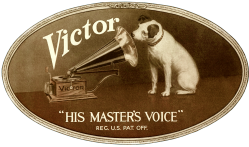
The Victor-Victrola Page

VV-VI
RARITY: ¤ VALUE: ¤

The
VV-VI or Victrola the Sixth, was a very popular tabletop "Victrola"
internal-horn phonograph; it was a 'step-up' model with a larger cabinet and
more powerful motor than the entry-level VV-IV model. Its
introduction in the summer of 1911 was concurrent with the launch of a wide lineup of newly-designed machines which included models such as the
VV-X and
VV-IX. Even though the VV-VI was a basic
'no-frills' machine, it featured a well-crafted solid oak cabinet, nickel
plated hardware, a two-spring motor, and Victor's Exhibition Soundbox. Along
with nearly all of the other newly-introduced models, sales of the VI were
strong from the start. Production of the VI ran for more than 11 years, which
was certainly a tribute to its success. It became Victor's second best-selling
model of all time
The earliest VV-VI machines (left) used simple wood baffles to direct the
sound from the tonearm base to the front horn-opening 'slats'; closable 'tone doors'
were used to control the sound volume. A 10" turntable was used. It was not until 1913 that an actual horn
assembly (consisting of a cast iron elbow and wood horn mouth) was used
internally to improve the sound volume. At the same time, the cabinet was
enlarged and the turntable was increased to a 12" diameter (picture at right). While many of the VI's design features
evolved over the years (see breakdown below), it remained about the same in form
and function as when it was when first introduced. The VV-VI was only
available in oak until about 1919, when mahogany became available as well. These cabinets, as was the case for all VV-IV
and VV-VI models, were made by outside suppliers; assembly of the mechanical
components was completed at the Victor plant in Camden, NJ.
Incremental suffix letters following the serial number represent incremental
changes to hardware and mechanical components. The original 1911 selling price
was $25.00, which equates to approximately $700.00 in today's money. Based on
factory documentation, a total of just over 697,000 Victrola VIII models were
produced; however, based on serial numbers of surviving examples, at least
705,000 were ultimately made. Production of the VI was terminated in the spring
of 1924; due to inflation, the retail price had risen to $35.00 by that time.
Interestingly, serialization of the VV-VI apparently did not start at "501" as
was the case for virtually all other Victrola models; based on a very large
population sample of surviving machines, it appears that the first VV-VI to roll
off the assembly line was tagged with a serial number of approximately 5400.
As with many other Victrola models, the VV-VI was a huge success for the company; but
between 1922 and 1924 when sales of Victrolas began to slow in favor of radio, Victor failed to
respond to the market changes by slowing their production rate. Therefore, in
spite of lagging sales, many thousands of these machines continued to come off
the assembly line, and the large network of dealers and distributors began
bursting at the seams with unsold Victrolas. Due to this massive overproduction,
it is likely that many late-production VV-VI models were shipped to markets in
Latin America, or sold during the company's 'half-price' sale during the summer
of 1925.
For more information on Victor's financial crisis of 1924-1925 and the
overproduction of phonographs, please click
here.
Due to the large volume that were originally produced, the VV-VI (and many
similar low-cost Victrola models) are typically ignored by collectors
today, unless in exceptional original condition. They are simply too basic in design, and far too many were produced to be considered 'collectible'
in the current market.
The survival database currently shows the earliest existent VV-VIII to be S/N 5424 and the latest to be S/N 711718
| Manufacture Date | Approximate Serial Number Range | Feature Notes |
| 1911 | 5400-10000 | 10-inch turntable, flat crank shank |
| 1912 | 10000-44000 | Some machines have an A or B suffix |
| 1913 | 44000-68000 | C suffix early in year. 12-inch turntable introduced at S/N 54500. |
| 1914 | 68000-117000 | C suffix ends. D suffix started at approx S/N 87600. E suffix started approx S/N 97200. F suffix started at S/N 103000. Round crank shank added and speed control moved to right front location with the start of F suffix. |
| 1915 | 117000-179500 | F suffix. Many machines with an F suffix have a dash mark after the "VV-VI" identification. |
| 1916 | 179500-259000 | F suffix |
| 1917 | 259000-362000 | F suffix for most of year. VI-A* designation used after 9/17 |
| 1918 | 362000-397000 | |
| 1919 | 397000-492500 | VI-A* designation ceases during mid year. |
| 1920 | 492500-583000 | |
| 1921 | 583000-605000 | |
| 1922 | 605000-645000 | |
| 1923 | 645000-680000 | |
| 1924 | 680000-712000 |
* Note: the "A" designator after the model indicates a revised motor design. The A was later dropped from the dataplate, but the improved motor remained
Do you own a Victrola VV-VI? Please take a moment and enter some basic information about your machine into the collector's database by clicking here. No personal information is required.